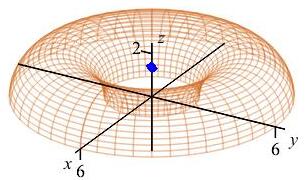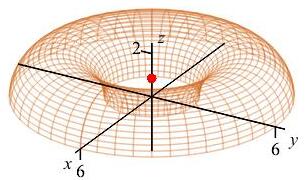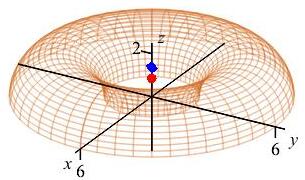21. Multiple Integrals in Curvilinear Coordinates
e. Integrating in 3D Curvilinear Coordinates
5. Applications
We previously did Applications of Multiple Integrals in Rectangular Coordinates and we have done Applications of Triple Integrals in Cylindrical Coordinates and Applications of Triple Integrals in Spherical Coordinates. All of those applications can also be done using general 3D curvilinear coordinates.
All the examples on this page of applications of triple integrals in curvilinear coordinates will use the upper half of a torus (donut) where the distance from the center of the hole to the center of the ring is \(4\) and the radius of the ring is \(2\). Find a curvilinear coordinate system for the solid. Then find the ranges of the coordinates to describe the solid and the Jacobian factor.
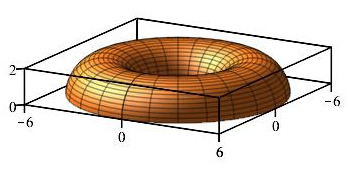
Slice through the torus vertically at some angle \(\theta\). This gives an \(rz\)-plane which intercets the torus in a circle of radius 2 centered at \((r,z)=(4,0)\). So its equation is \((r-4)^2+z^2=4\) which may be parametrized by: \[ r=4+2\cos\phi \qquad \text{and} \qquad z=2\sin\phi \] If we change the radius of the circle from \(2\) to \(t\) with \(0 \le t \le 2\), we get a smaller circle inside. Putting these together, we get a parametrization of the inside of the original circle as: \[ r=4+t\cos\phi \qquad \text{and} \qquad z=t\sin\phi \]
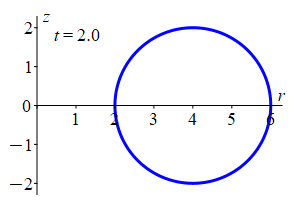
Plugging this into cylindrical coordinates: \[ \vec{R}(r,\theta,z)=\left\langle r\cos\theta,r\sin\theta,z\right\rangle \] we get the toroidal coordinate system: \[ \vec{R}(t,\theta,\phi) =\left\langle (4+t\cos\phi)\cos\theta,(4+t\cos\phi)\sin\theta,t\sin\phi\right\rangle \] The coordinate ranges for the inside of the half-donut are: (Note: \(\phi\) stops at \(\pi\) to give a half circle.) \[ 0 \le t \le 2 \qquad 0 \le \phi \le \pi \qquad 0 \le \theta \le 2\pi \] The coordinate tangent vectors are: \[\begin{aligned} \vec{e}_t&=\dfrac{\partial\vec{R}}{\partial t} =\left\langle \cos\phi\cos\theta,\cos\phi\sin\theta,\sin\phi\right\rangle \\ \vec{e}_\theta&=\dfrac{\partial\vec{R}}{\partial\theta} =\left\langle -(4+t\cos\phi)\sin\theta,(4+t\cos\phi)\cos\theta,0\right\rangle \\ \vec{e}_\phi&=\dfrac{\partial\vec{R}}{\partial\phi} =\left\langle -t\sin\phi\cos\theta,-t\sin\phi\sin\theta,t\cos\phi\right\rangle \end{aligned}\] Then the Jacobian determinant is: (We expand on the second row.) \[\begin{aligned} \dfrac{(x,y,z)}{(t,\phi,\theta)} &=\begin{vmatrix} \cos\phi\cos\theta & \cos\phi\sin\theta & \sin\phi \\ -(4+t\cos\phi)\sin\theta & (4+t\cos\phi)\cos\theta & 0 \\ -t\sin\phi\cos\theta & -t\sin\phi\sin\theta & t\cos\phi \end{vmatrix} \\ &=(4+t\cos\phi)\sin\theta\begin{vmatrix} \cos\phi\sin\theta & \sin\phi \\ -t\sin\phi\sin\theta & t\cos\phi \end{vmatrix} \\ &\quad+(4+t\cos\phi)\cos\theta\begin{vmatrix} \cos\phi\cos\theta & \sin\phi \\ -t\sin\phi\cos\theta & t\cos\phi \end{vmatrix} \\ &=(4+t\cos\phi)\sin\theta\left( t\cos^2\phi\sin\theta+t\sin^2\phi\sin\theta \right) \\ &\quad+(4+t\cos\phi)\cos\theta\left( t\cos^2\phi\cos\theta+t\sin^2\phi\cos\theta \right) \\ &=t(4+t\cos\phi)\sin^2\theta+t(4+t\cos\phi)\cos^2\theta \\ &=t(4+t\cos\phi) \end{aligned}\] And the Jacobian is: \[\begin{aligned} J=t(4+t\cos\phi)=4t+t^2\cos\phi \end{aligned}\] since \(t\) is positive. Finally, the differential of volume is: \[ dV=(4t+t^2\cos\phi)\,dt\,d\phi\,d\theta \]
Volume
Find the volume of the half-donut.
Mass
Find the mass of the half-donut if the mass density is \(\delta=z^2\).
Center of Mass
Find the center of mass of the half-donut if the mass density is \(\delta=z^2\).
Centroid
Find the centroid of the half-donut.
Average Value
Find the average temperature of the half-donut if the temperature is \(T=270-z\).
The exercises the rest of this page refer to the upper half of the ellipsoid \(x^2+4y^2+9z^2=36\) discussed on the previous page. We use the same ellipsoidal spherical coordinate system: \[\begin{aligned} x&=6\rho\sin\phi\cos\theta \\ y&=3\rho\sin\phi\sin\theta \\ z&=2\rho\cos\phi \end{aligned}\]
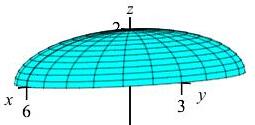
For the upper half of the ellipsoid, the bounds are: \[ 0 \le \rho \le 1 \qquad 0 \le \phi \le \dfrac{\pi}{2} \qquad 0 \le \theta \le 2\pi \] (Note: \(\phi\) stops at \(\dfrac{\pi}{2}\) to give the upper half of the ellipsoid.) As discussed on the previous page, the Jacobian is: \[ J=36\rho^2\sin\phi \] which will be derived on the exercise page.
Find the volume of the half ellipsoid.
\(V=24\pi\)
The volume is: \[\begin{aligned} V&=\iiint\limits_R 1\,dV =\iiint\limits_R 36\rho^2\sin\phi\,d\rho\,d\phi\,d\theta \\ &=\int_0^{2\pi}\int_0^{\pi/2}\int_0^1 36\rho^2\sin\phi\,d\rho\,d\phi\,d\theta \\ &=36\int_0^{2\pi} \,d\theta\int_0^{\pi/2} \sin\phi\,d\phi\int_0^1 \rho^2\,d\rho \\ &=36(2\pi)\left[\rule{0pt}{10pt}-\cos\phi\right]_0^{\pi/2}\left[\dfrac{\rho^3}{3}\right]_0^1 =24\pi \end{aligned}\]
The high school geometry formula for the volume of an ellipsoid is: \[ V=\dfrac{4}{3}\pi \,a\,b\,c =\dfrac{4}{3}\pi \,6\cdot3\cdot2 =48\pi \] Our result is correctly half of this.
Find the mass of the half ellipsoid if the density is \(\delta=z+2\).
\(M=66\pi\)
First, we convert the density function to ellipsoidal spherical coordinates: \[ \delta=z+2=2\rho\cos\phi+2 \] The mass of the ellipsoid is found by integrating the density function over the volume: \[\begin{aligned} M&=\iiint\limits_R \delta\,dV=\iiint\limits_R (2\rho\cos\phi+2)36\rho^2\sin\phi\,d\rho\,d\phi\,d\theta \\ &=72\int_0^{2\pi}\int_0^{\pi/2}\int_0^1 (\rho^3\sin\phi\cos\phi+\rho^2\sin\phi)\,d\rho\,d\phi\,d\theta \\ &=72\int_0^{2\pi} \,d\theta \left[\int_0^{\pi/2}\sin\phi\cos\phi\,d\phi\int_0^1 \rho^3\,d\rho +\int_0^{\pi/2}\sin\phi\,d\phi\int_0^1 \rho^2\,d\rho\right] \\ &=144\pi \left(\left[\dfrac{\sin^2\phi}{2}\right]_0^{\pi/2}\left[\dfrac{\rho^4}{4}\right]_0^1 +\left[-\cos\phi\dfrac{}{}\right]_0^{\pi/2}\left[\dfrac{\rho^3}{3}\right]_0^1\right) \\ &=144\pi\left[\left(\dfrac{1}{2}\right)\left(\dfrac{1}{4}\right)+(1)\left(\dfrac{1}{3}\right)\right] =144\pi\left(\dfrac{11}{24}\right) =66\pi \end{aligned}\]
Find the center of mass of the half ellipsoid if the density is \(\delta=z+2\).
The center of mass is at:
\(\left\langle \bar{x},\bar{y},\bar{z}\right\rangle
=\left\langle 0,0,\dfrac{46}{55}\right\rangle
=\langle 0,0,.84\rangle\)
By symmetry \(\bar{x}=\bar{y}=0\). We need to compute \(\bar{z}=\dfrac{M_z}{M}\). We already have the mass of the ellipsoid: \(M=66\pi\). The \(z\)-moment of mass is: \[\begin{aligned} M_z&=\iiint_R z\,\delta\,dV =\iiint_R (2\rho\cos\phi)(2\rho\cos\phi+2)36\rho^2\sin\phi\,d\rho\,d\phi\,d\theta \\ &=288\pi\int_0^{\pi/2}\int_0^1 (\rho^4\cos^2\phi\sin\phi+\rho^3\cos\phi\sin\phi)\,d\rho\,d\phi \\ &=288\pi\left[\int_0^{\pi/2}\int_0^1 \rho^4\cos^2\phi\sin\phi\,d\rho\,d\phi +\int_0^{\pi/2}\int_0^1 \rho^3\cos\phi\sin\phi\,d\rho\,d\phi\right] \\ &=288\pi\left[\int_0^{\pi/2}\cos^2\phi\sin\phi\,d\phi\int_0^1 \rho^4\,d\rho +\int_0^{\pi/2}\cos\phi\sin\phi\,d\phi\int_0^1 \rho^3\,d\rho\right] \\ &=288\pi\left(\left[\dfrac{-\cos^3\phi}{3}\right]_0^{\pi/2}\left[\dfrac{\rho^5}{5}\right]_0^1 +\left[\dfrac{\sin^2\phi}{2}\right]_0^{\pi/2}\left[\dfrac{\rho^4}{4}\right]_0^1\right) \\ &=288\pi\left[\left(\dfrac{1}{3}\right)\left(\dfrac{1}{5}\right) +\left(\dfrac{1}{2}\right)\left(\dfrac{1}{4}\right)\right] =288\pi\left(\dfrac{23}{120}\right) =\dfrac{276}{5}\pi \end{aligned}\]
Therefore the \(z\) component of the center of mass is: \[ \bar{z}=\dfrac{M_z}{M} =\dfrac{276\pi}{5}\dfrac{1}{66\pi}=\dfrac{46}{55}=0.84 \] So the center of mass is at: \[\begin{aligned} \left\langle \bar{x},\bar{y},\bar{z}\right\rangle =\left\langle 0,0,\dfrac{46}{55}\right\rangle =\langle 0,0,.84\rangle \end{aligned}\] The center of mass is plotted within the half ellipsoid as a blue diamond.
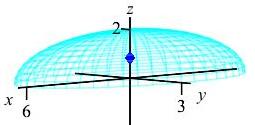
Find the centroid of the half ellipsoid.
The centroid is at:
\(\left\langle \bar{x},\bar{y},\bar{z}\right\rangle
=\left\langle 0,0,\dfrac{3}{4}\right\rangle
=\langle 0,0,0.75\rangle\)
By symmetry \(\bar{x}=\bar{y}=0\). We need to compute \(\bar{z}=\dfrac{V_z}{V}\). We already have the volume of the half-ellipsoid: \(V=24\pi\). The \(z\)-moment of volume is: \[\begin{aligned} V_z&=\iiint_R z\,dV \\ &=\int_0^{2\pi}\int_0^{\pi/2}\int_0^1 (2\rho\cos\phi)36\rho^2\sin\phi\,d\rho\,d\phi\,d\theta \\ &=144\pi\int_0^{\pi/2} \cos\phi\sin\phi\,d\phi\int_0^1 \rho^3\,d\rho \\ &=144\pi\left[\dfrac{\sin^2\phi}{2}\right]_0^{\pi/2}\left[\dfrac{\rho^4}{4}\right]_0^1 \\ &=144\pi\left(\dfrac{1}{2}\right)\left(\dfrac{1}{4}\right) =18\pi \end{aligned}\]
Now we compute \(\bar{z}\) by \[ \bar{z}=\dfrac{V_z}{V} =\dfrac{18\pi}{24\pi}=\dfrac{3}{4}=0.75 \] So the center of mass is at: \[\begin{aligned} \left\langle \bar{x},\bar{y},\bar{z}\right\rangle =\left\langle 0,0,\dfrac{3}{4}\right\rangle =\langle 0,0,0.75\rangle \end{aligned}\] The centroid is plotted within the half-ellipsoid as a red sphere.
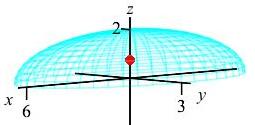
The center of mass is plotted as a blue diamond.
The centroid is plotted as a red sphere.
The center of mass, \(\bar{z}=0.84\), is above the centroid, \(\bar z=.75\),
because the density, \(\delta=z+2\), increases with \(z\).

Compute the average of the temperature, \(T=270-z^2\), over the ellipsoid.
\(T_\text{ave}=269.2\)
The average temperature is: \[\begin{aligned} T_\text{ave}&=\dfrac{1}{V}\iiint_R T\,dV =\dfrac{1}{V}\iiint_R 270-z^2\,dV \\ &=\dfrac{270}{V}\iiint_R 1\,dV-\dfrac{1}{V}\iiint_R z^2\,dV \end{aligned}\] The first integral is the volume and the second is: \[\begin{aligned} \iiint_R z^2\,dV &=\int_0^{2\pi}\int_0^{\pi/2}\int_0^1 (2\rho\cos\phi)^2 36\rho^2\sin\phi\,d\rho\,d\phi\,d\theta \\ &=288\pi\int_0^\pi \cos^2\phi\sin\phi\,d\phi\int_0^1 \rho^4\,d\rho \\ &=288\pi\left[\dfrac{-\cos^3\phi}{3}\right]_0^{\pi/2}\left[\dfrac{\rho^5}{5}\right]_0^1 \\ &=288\pi\left(\dfrac{1}{3}\right)\left(\dfrac{1}{5}\right) =\dfrac{96}{5}\pi \end{aligned}\] Since \(V=24\pi\), we have: \[\begin{aligned} T_\text{ave}&=270\dfrac{V}{V}-\dfrac{1}{V}\iiint_R z^2\,dV \\ &=270-\dfrac{1}{24\pi}\dfrac{96\pi}{5} =270-\dfrac{4}{5} =269.2 \end{aligned}\]
Heading
Placeholder text: Lorem ipsum Lorem ipsum Lorem ipsum Lorem ipsum Lorem ipsum Lorem ipsum Lorem ipsum Lorem ipsum Lorem ipsum Lorem ipsum Lorem ipsum Lorem ipsum Lorem ipsum Lorem ipsum Lorem ipsum Lorem ipsum Lorem ipsum Lorem ipsum Lorem ipsum Lorem ipsum Lorem ipsum Lorem ipsum Lorem ipsum Lorem ipsum Lorem ipsum
